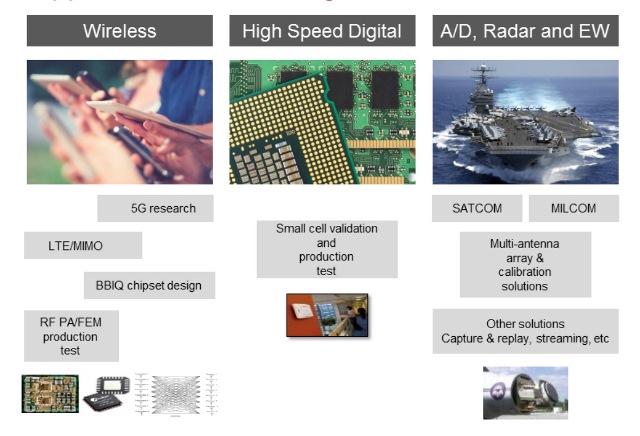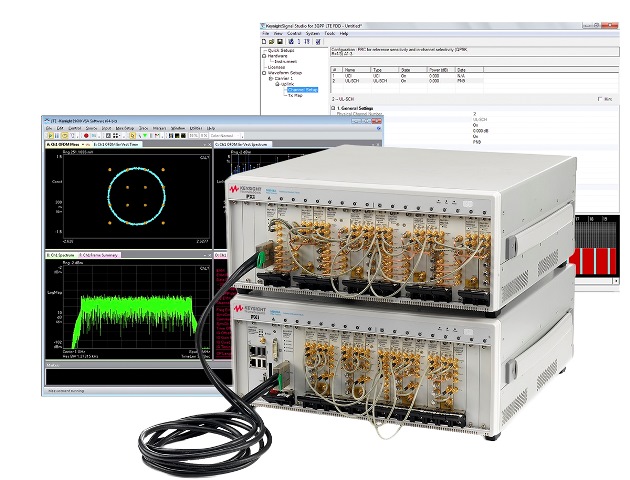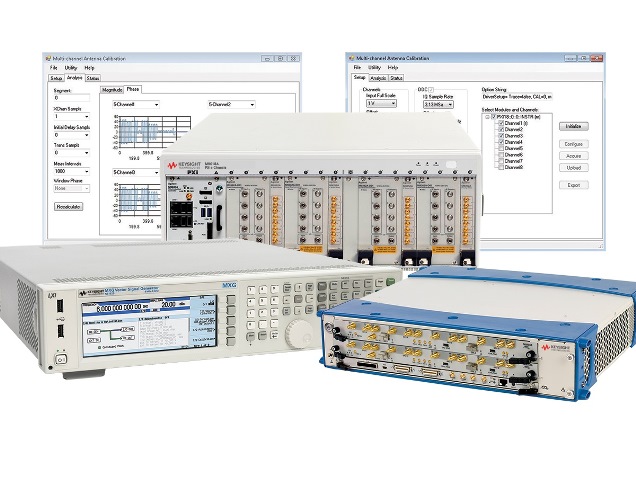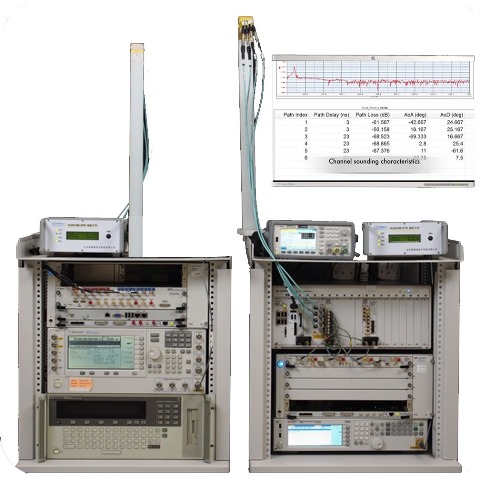By JIM ARMENTROUT
Global Modular Solutions Manager
Keysight Technologies, Inc.
Manufacturers of new electrical devices for commercial wireless communications are always looking for ways to drive down costs while improving the performance or adding features to their new devices. As a result, additional tests and improved measurement systems are needed for these more complex devices. To meet the needs of a global manufacturer in a fast-paced market, these new or upgraded test systems need to be more than just fast; they need to deliver accurate, repeatable results and advanced measurements, test capability, and performance. But moving to a new or upgraded test platform involves a certain amount of effort and risk.
In moving to a new platform, the manufacturer not only faces a sizeable software effort, but could also spend months evaluating a system configuration that, in the end, turns out to be unsuitable for the application. To start, some level of programming expertise is required for test code development, as well as a deeper understanding of measurement science for testing of complex applications. Test equipment evaluations can lead to selection of a combination of instruments that meet specific test needs. Then, the challenge is to integrate the instruments and software into a test system with optimal performance and accurate results.
Many times the instrument configurations and measurements must be edited and re-run to progressively determine the parameters and sequence that achieve the specified test system goals. The performance-verification ability of the newly combined instruments and software may be difficult to determine. When a solution is created to test devices featuring new, breakthrough technology, the engineers are left questioning whether the performance of the test system or the device under test is correct. Engineers must successfully overcome these system-development hurdles to achieve their ultimate test system goals.
Ever-shrinking design cycles have compelled test engineers to look for alternative solutions – ways to re-use or leverage test ideas from others. In some cases, this has led to collaborations between instrumentation suppliers and manufacturers’ internal test groups, which have resulted in optimal configurations of hardware and software to address specific test challenges. Some of those test configuration ideas have been packaged with open-source programming code examples. Today, Keysight Technologies offers such configurations under the banner of Reference Solutions, in much the same way as device manufacturers offer reference designs so their customer have a leg up on integrating those devices into their designs.
The Reference-Solution solution
Basically, Reference Solutions are test-system configurations that typically include multiple test instruments in PXI, AXIe, or benchtop form factors, along with associated software drivers, measurement algorithms, and sample programs. Instrument hardware selection is made to optimize speed and performance for specific applications, while taking advantage of the benefits of flexibility and scalability that modular instrumentation offers. These solutions not only deliver the test results engineers need today, but also enable new capabilities for future test demands that simply weren’t possible in the past.
Virtually any type of instrument can become a component within a larger, application-specific reference solution. Speed-optimized PXI signal-generator modules, for example, can be used for production testing of wireless devices, while modular high-performance, high-fidelity AXIe arbitrary-waveform generators (AWGs) can be used for research and radar simulations. Applications in the analog, digital, and RF/microwave technology arenas, each of which has their own unique set of test needs and challenges that must be addressed, all benefit from this approach (Fig. 1 ).

Fig. 1: Applications with unique test challenges — such as wireless, high-speed digital, and A/D, radar, and electronic warfare — can all benefit from a Reference-Solutions approach .
What makes Reference Solutions especially useful is that they’ve been developed and successfully implemented in actual test environments, where complex and time-consuming test system development tasks — including instrument and software selection, configuration and validation — have been addressed. Solution enhancements requested by industry experts have resulted in specifications that offer leading-edge test solutions for those applications. Yet because they are flexible solutions, engineers can add application-specific test routines, more channels, additional measurements, and proprietary algorithms. Thus these engineers can satisfy technical commitments by receiving and implementing a complete test solution which they fine tune for their application specific needs, and still meet aggressive test development schedules with a high-performance solution.
Reference Solution examples
A number of Reference Solutions have come to market in the last year that address a wide range of applications. For instance, to examine timing and signal-quality issues in complex carrier aggregation and MIMO/beamforming designs, a reference solution for wireless can let engineers quickly view multiple antenna elements simultaneously and analyze RF performance and modulation domains. The Reference Solution for LTE/LTE-A multi-channel test (Fig. 2 ) is a compact PXI signal-generation and analysis-test solution offering up to eight channels that are time synchronous and phase coherent. Signal Studio software is used to create complex LTE-A waveforms, and 89600 VSA/WLA software is used to connect to multiple analyzers. The solution is configurable for specific wireless test needs.

Fig. 2: The PXI-based Reference Solution for LTE/LTE-A multi-channel test can provide up to eight channels that are time synchronous and phase coherent.
Another is the Reference Solution for RF PA/FEM characterization and test (Fig. 3 ). Production testing of power-amplifiers (PAs) front-end-modules (FEMs) benefits from improved data throughput and reduced manufacturing costs. For FEMs, the Reference Solution uses a two-port vector-network analyzer (VNA) for characterization of the passive components of the power amplifiers’ front-end module, and a measurement accelerator is used to make closed/open loop digital pre-distortion and envelope tracking measurements in the tens of milliseconds. The Reference Solution provides power-amplifier module characterization for PAD and other devices, and includes measurements for S parameters, demodulation, power, adjacent-channel power, and harmonic distortion. Test-code examples show how to optimize test throughput without compromising performance.

Fig. 3: The Reference Solution for RF PA/FEM characterization and test combines AXIe and PXI instruments for characterization of power amplifiers and front-end modules.
Another instance is the Multi-Channel Antenna Test Reference Solution (Fig.4 ). This platform, which combines hardware and software to address narrowband antenna calibration test, has a flexible configuration with a scalable number of channels, options for down-conversion of antenna-receive channels, selectable analysis bandwidth, and a selection of RF/microwave sources. The main components in the solution include a vector-signal analyzer, vector-signal generator, vector network analyzer, digital stimulus/response, a measurement accelerator, and Signal Studio software.

Fig. 4: The Multi-Channel Antenna Test Reference Solution is a mix of traditional, PXI, and AXIe modules with a scalable number of channels.
The 5G Channel Sounding Reference Solution (Fig. 5 ) provides a flexible configuration of hardware and software to transmit and measure in millimeter wave frequencies, offering wide transmit and analysis bandwidth with real-time data processing. The configuration consists of instruments including a wideband digitizer, microwave analog-signal generator, vector-signal generator, arbitrary-waveform generator, VSA software, and Waveform Creator software.

Fig. 5: The 5G Channel Sounding Reference Solution provides a flexible configuration of hardware and software to transmit and measure in millimeter wave frequencies.
In general, then, Reference Solutions address specific application-test challenges. Each solution integrates application-specific input from industry design engineers and researchers with Reference Solution provider’s expertise in measurement instrumentation and software. Various collaborations have already resulted in cutting-edge test capabilities packaged in test-system configurations that can provide engineers with faster time to first measurement and more. Using provided documentation and programming examples, the proven combinations of hardware and software can be quickly evaluated, implemented and upgraded to meet current and future test requirements.
Advertisement
Learn more about Keysight Technologies, Inc.





